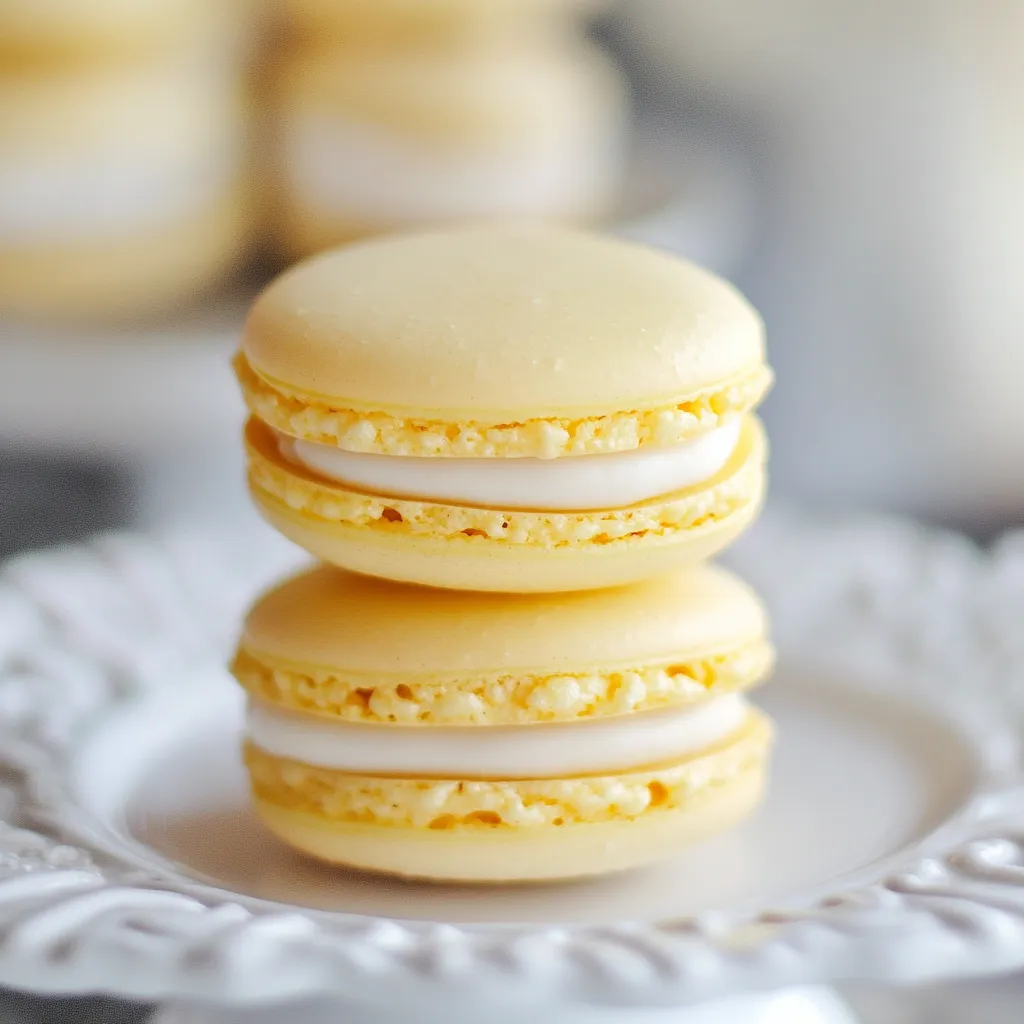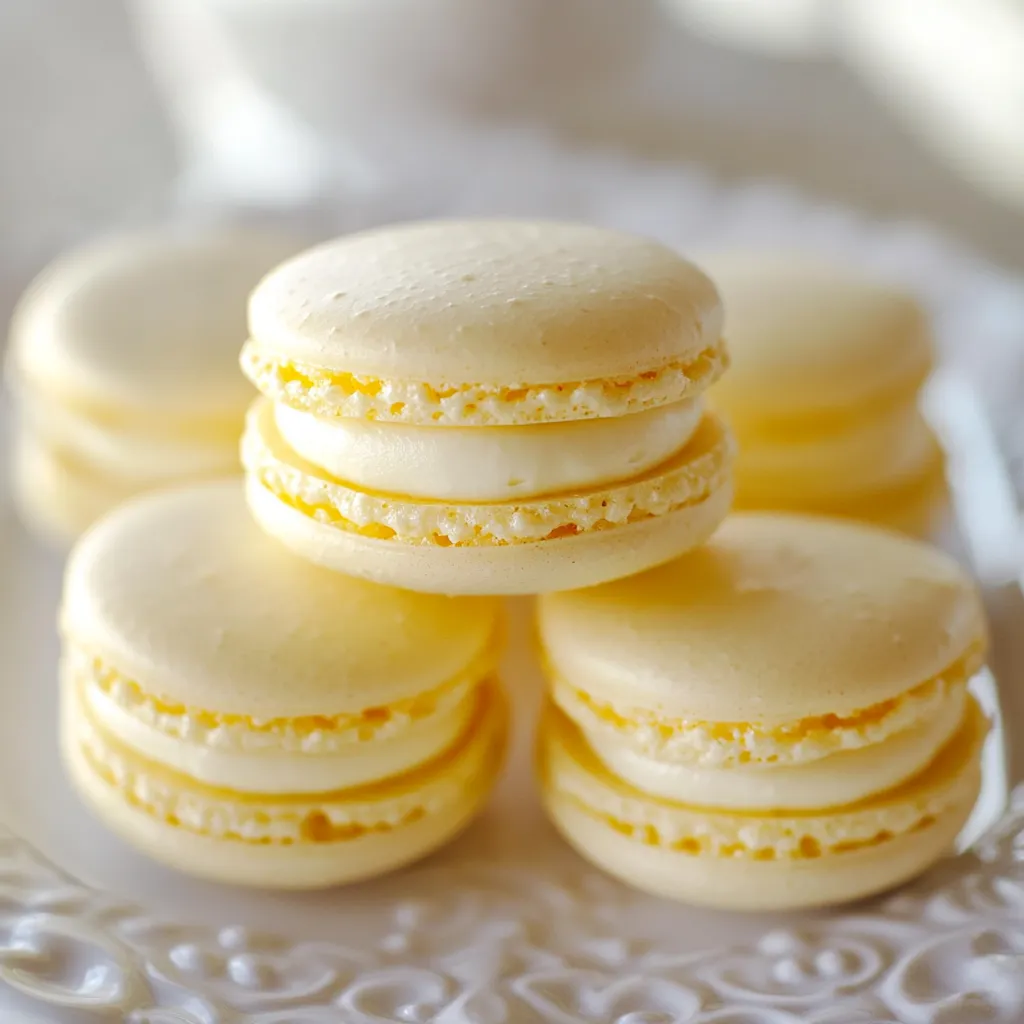 Pin it
Pin it
This lemon cheesecake macaron recipe transforms simple ingredients into elegant French cookies that balance tangy lemon and creamy cheesecake flavors. Even amateur bakers can achieve these professional-looking treats with my detailed instructions.
I first made these macarons for my sister's bridal shower, and they became the unexpected star of the dessert table. Now they're my signature contribution to every family gathering.
Ingredients
- 300g white chocolate: Provides the creamy base for our ganache filling
- 200g heavy whipping cream: Adds richness while helping melt the chocolate
- 100g cream cheese: Room temperature, gives that authentic cheesecake flavor
- 20g glucose syrup: Creates a silky smooth texture and prevents crystallization
- 150g lemon curd: Brings bright citrus flavor to balance the sweetness
- 125g almond flour: Use blanched and finely ground for best results
- 150g powdered sugar: Sift carefully to eliminate any lumps
- 100g egg whites: From about 3 large eggs, aged at room temperature for stability
- 100g white granulated sugar: Gradually added to create meringue structure
- 1g yellow food coloring: Creates the sunny appearance
Step-by-Step Instructions
- Prepare Cheesecake Ganache:
- Warm heavy cream and glucose in a small saucepan until just steaming but not boiling. Pour over white chocolate in a heatproof bowl and let sit undisturbed for one minute to allow the chocolate to begin melting. Stir gently with a silicone spatula until completely smooth. Add room temperature cream cheese and blend with an immersion blender until perfectly silky with no lumps. Press plastic wrap directly onto the surface of the ganache to prevent a skin from forming and refrigerate at least 6 hours or overnight to firm up properly.
- Create Macaron Shells:
- Sift almond flour and powdered sugar together in a large bowl at least twice to ensure no lumps remain. In a stand mixer fitted with the whisk attachment, begin whipping room temperature egg whites on low speed. Once they become foamy, gradually add granulated sugar one tablespoon at a time. Add yellow food coloring and increase mixer speed to medium high. Continue whipping until stiff peaks form and the meringue is glossy. This process takes patience, usually 10 to 15 minutes of mixing.
- Perfect the Macaronage:
- Add the dry ingredients to the meringue and begin folding gently but firmly with a silicone spatula. The goal is to deflate some air while maintaining structure. The batter is ready when it flows from your spatula like molten lava, forming a ribbon that slowly disappears back into the batter within about 30 seconds. Transfer to a piping bag fitted with a round tip.
- Pipe and Rest:
- Pipe 1.5 inch rounds onto baking sheets lined with silicone mats or parchment paper. Tap the baking sheets firmly against the counter several times to release air bubbles. Allow shells to rest at room temperature until they develop a dry skin that does not stick to your finger when lightly touched. This typically takes 30 to 60 minutes depending on humidity.
- Bake to Perfection:
- Bake in a preheated oven at 275°F to 300°F for 12 to 14 minutes. The shells should develop feet but remain pale in color. Allow to cool completely on the baking sheet before attempting to remove them. Once cooled, pair shells of similar size together for assembly.
- Assemble with Care:
- Transfer cheesecake ganache to a piping bag and pipe a ring around the outer edge of one macaron shell. This creates a barrier to hold the lemon curd. Pipe lemon curd into the center of the ganache ring. Gently place a second shell on top and press ever so slightly to adhere the shells together without crushing them.
- Rest for Best Flavor:
- Place assembled macarons in an airtight container and refrigerate for 12 to 24 hours to mature. This resting period allows flavors to meld and the shells to soften slightly for the perfect texture.
 Pin it
Pin it
The lemon curd is truly the heart of this recipe. I source Meyer lemons when they're in season for a more complex flavor that reminds me of the lemon trees in my grandmother's backyard. Every time I make these, the vibrant yellow color brings back memories of picking those sun-ripened fruits with her.
Troubleshooting Common Macaron Problems
Hollow shells often result from undermixed batter or improper oven temperature. If your macarons have hollow centers, try mixing the batter slightly more during the macaronage stage or adjusting your oven temperature down by 10 degrees. Every oven has hot spots, so rotating the pan halfway through baking can help ensure even cooking.
Seasonal Variations
During summer, replace the lemon curd with fresh berry compote for a seasonal twist. Raspberry pairs exceptionally well with the cheesecake ganache. In fall, try adding a pinch of cinnamon to the shells and using apple butter as the filling center. The beauty of this base recipe is its versatility to adapt to seasonal ingredients and preferences.
Make-Ahead Tips
The ganache can be prepared up to 3 days in advance and kept refrigerated. Macaron shells can be baked and stored unfilled in an airtight container at room temperature for up to 3 days or frozen for up to a month. This makes them perfect for preparing in stages when time is limited.
 Pin it
Pin it
These macarons make any occasion extra special with their elegant appearance and amazing flavor. Practice makes perfect, so enjoy the process!
Frequently Asked Questions
- → Why do macarons need to mature in the refrigerator?
Macarons need 12-24 hours to mature in the refrigerator after assembly because this resting period allows moisture from the filling to slightly soften the shells and helps the flavors meld together. This maturation process transforms the initially crisp shells into the perfect chewy texture that's characteristic of excellent macarons.
- → Can I make the cheesecake ganache in advance?
Yes, the cheesecake ganache can be made 1-2 days in advance. After preparing it, store it in an airtight container in the refrigerator with plastic wrap pressed directly onto the surface to prevent a skin from forming. Allow it to come to a pipeable consistency before assembling the macarons.
- → Why did my macaron shells crack during baking?
Cracked macaron shells usually result from insufficient resting time before baking. Shells need to form a dry skin on top (no batter should stick to your finger when touched) which allows steam to escape from the bottom during baking rather than cracking the top. Other causes could be oven temperature that's too high or undermixed batter.
- → Can I use bottled lemon juice instead of lemon curd?
Bottled lemon juice is not a suitable substitute for lemon curd in this recipe. Lemon curd has a thicker consistency and contains eggs, sugar and butter which contribute to both flavor and texture. If you don't have store-bought lemon curd, it's better to make your own or consider a different filling altogether.
- → How do I know when my macaron batter has reached the right consistency?
The perfect macaron batter consistency is often described as flowing like 'lava.' When lifted with a spatula, it should fall in a ribbon and slowly reincorporate into the remaining batter, eventually disappearing. If it's too thick, continue folding; if it's too runny, you've overmixed and may need to start again. The figure-8 test is helpful: the batter should flow continuously while drawing a figure 8 without breaking.
- → What can I use instead of glucose syrup in the ganache?
If you don't have glucose syrup, you can substitute with corn syrup or honey as they all help prevent crystallization and add smoothness to the ganache. However, honey will impart its own flavor which might affect the final taste. Light corn syrup is the closest substitute that won't significantly alter the flavor profile.
